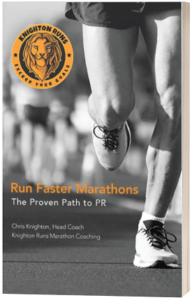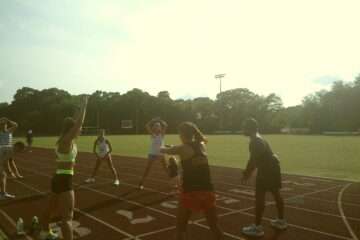Four Ways A Running Coach Has Improved My Outlook
I’m working less and getting better, injury-free results
By Bob Merckel, Knighton Runs Athlete

Have you ever been overwhelmed by the number of ways to improve yourself?
For the past several years, I’ve tried all kinds of programs to get me back into running. Hiring a coach a few months ago was the best decision I’ve made.
Three years ago, I was a month away from getting a PR in the half-marathon. Granted, my half is only a little faster than elite runners’ full marathons, but I’ve never trained to be an elite athlete. In running, like a lot of things in life, you have to accept where you are and move onwards and upwards from there.
I had trained hard, too hard in fact. I remember a friend telling me, “For someone who runs every day, you sure do move slowly.”
I ended up with hip issues that not only kept me from competing, but had me walking around my flat without looking like Tim Conway’s Oldest Man.
Each time I went back on the road (or the nefarious dreadmill), I’d try to pick up where I left off.
This left me either re-injured or completely demotivated.
Working with an expert has made me focused and effective
As I approach 60, I’ve seen too many people (relatives included) lose not only their fitness but their basic mobility. I am determined not to let this happen to me.
So, I did some research and talked to a number of coaches before finding one with whom we felt a mutual “click”. Working with him has provided me four remarkable benefits:
- I’m more confident in my current ability, it is consistently improving
- I’m saving time and energy by not having to worry about “what do I do next”
- I’m becoming more consistent
- I’m seeing, and feeling, tangible results
Honestly, it’s one of the smartest investments I’ve ever made.
Trust that your training is based on where you are.
I’ve always struggled with training at “where I am vs”. “where I want to be.”
When I’ve used cookie-cutter training programs in the past, even when they’re from expert sources like Hal Higdon, I’ve never been happy with saying “I’m at level x.”. If I re-start a beginner level, I often try to outdo it. If I opt for something more challenging, I might not hit the targets and then feel discouraged or even defeated.
My coach continually assesses where I am based on occasional time trials and/or races and my own post-run feedback. Each week’s schedule is tweaked based on how I’m performing and how I’m feeling.
Save time and energy by not planning workouts, and making sure that easy runs are easy.
I don’t have to think about what to do anymore, I just look at the schedule and get it done.
No longer do I second guess what the cookie-cutter says. I get a weekly schedule and I just go out and do it.
“Running too hard too often is the single most common and detrimental mistake in the sport.” — Matt Fitgerald
My coach is a big proponent of this, as well as “forget about pace when you’re not racing or doing speed work”. This was a huge adjustment for me, and to be honest, I still look at my Garmin more than I should. So many of the other programs or apps I’ve used push me to “Go, go, go”.
Now I run by feel … and easy runs are just that. I’ve learned to be content running at a comfortable pace, and I am consistently seeing that weekly “comfortable pace” get faster.
Accountability helps consistency
Having to give post-run feedback, and then having weekly check-ins has not made me only more accountable, but more consistent.
Hal Higdon, or any of the lovely trainers on my Peloton app, don’t know (or probably care) if I skip a workout. But now I have accountability. There have been more than a few days when I’m really comfortable on the sofa, or it’s raining, and I’m just not feeling the run. Then I think, “Oh, I can’t just tell Coach, I just didn’t feel like it.” I am way too much of a people pleaser for that. So I go out and do it anyway.
Go ahead and @ me for not having self-discipline, I’ll be fine. I’ve beat myself up about it for decades. But now I have someone to report to, which is extremely motivating. It’s never too late to change.
Achieve tangible results
I’ve slowed down to get faster. I’m increasing my weekly mileage and I’m staying injury free.
When I started last May, I was running three days a week, 20 minutes a run. A little over 5 miles a week with an average pace of 13:50 minutes per mile.
Last week I ran 26 miles, with an average pace of 13:12. But, that includes a very slow 10-miler; most of my runs are averaging in the mid-12-minute range. And they’re not that challenging.
At the end of the day, I feel better about my running than I have in years. I’m not competing against anyone else, and I’ve tried to stop competing against myself.
On October 24, I’ll be on the starting line in Valencia, Spain to run that half I was supposed to run in 2019. I know I won’t PR, and I’m okay with that. I see how much progress we’ve made in the past few months, and I’m already thinking about spring races.
We can all do hard things. We don’t have to do them alone.



